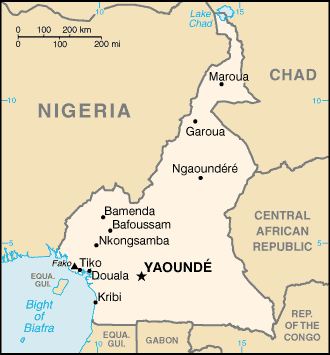 |
usa | world | animals | vocabulary | health | science | math | history |
Cameroon Map Courtesy CIA World Factbook
The first inhabitants of Cameroon were the pygmy Baka tribes. The Bantu language originated in the highlands of Cameroon, but many of its speakers moved out before foreign invaders came into the nation. The first European contact was in the 1500s with the Portuguese, but they did not stay. The first permanent settlements were started in the late 1870s, with Germany emerging as the major European Power. After World War I though, the country would be split by Britain and France. In 1961 the French and British portions of Cameroon were united, the French portion having gained independence a year earlier. The new coalition government was led by Ahmadou Ahidjo who led a crack down on rebel groups who had remained since before independence. Ahidjo stepped down in 1982 and was succeeded by the current president, Paul Biya. Biya has won numerous elections, but the fairness of these elections has been questioned. The last elections were held on October 11, 2004. |
 The Republic of Cameroon is a unitary republic of central Africa. It borders Nigeria, Chad, Central African Republic, Republic of Congo, Gabon, Equatorial Guinea and the Gulf of Guinea. The former French Cameroon and part of British Cameroons merged in 1961 to form the Federal Republic of Cameroon which in 1972 was renamed the United Republic of Cameroon; since 1984 the country is known as the Republic of Cameroon or République du Cameroun (its official languages are English and French). Cameroon has generally enjoyed stability, which has permitted the development of agriculture, roads, and railways, as well as a petroleum industry. Despite movement toward democratic reform, political power remains firmly in the hands of an ethnic oligarchy. The capital is Yaoundé.
The Republic of Cameroon is a unitary republic of central Africa. It borders Nigeria, Chad, Central African Republic, Republic of Congo, Gabon, Equatorial Guinea and the Gulf of Guinea. The former French Cameroon and part of British Cameroons merged in 1961 to form the Federal Republic of Cameroon which in 1972 was renamed the United Republic of Cameroon; since 1984 the country is known as the Republic of Cameroon or République du Cameroun (its official languages are English and French). Cameroon has generally enjoyed stability, which has permitted the development of agriculture, roads, and railways, as well as a petroleum industry. Despite movement toward democratic reform, political power remains firmly in the hands of an ethnic oligarchy. The capital is Yaoundé.